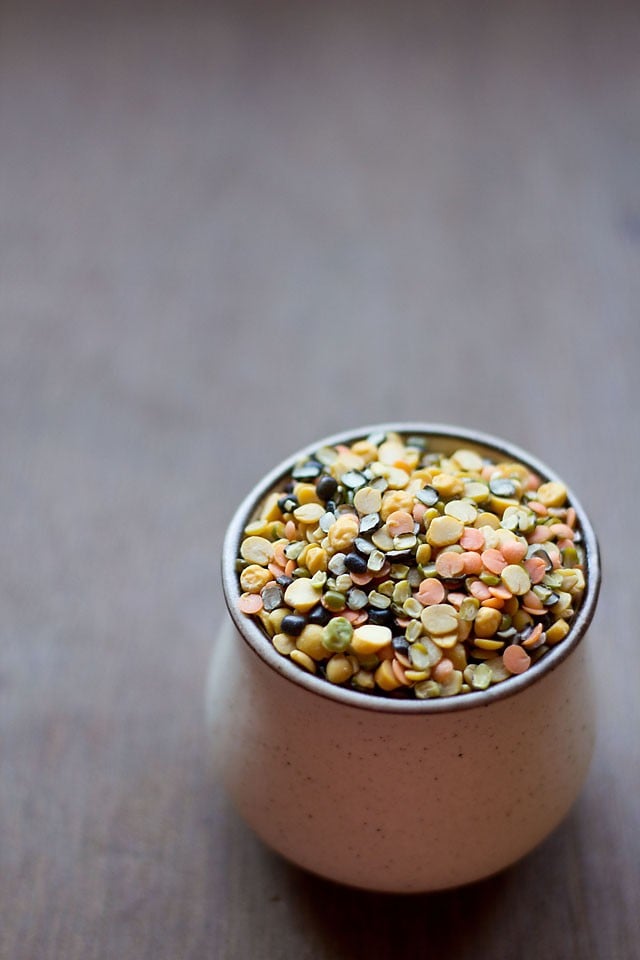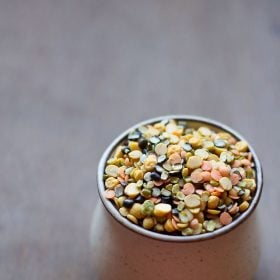The glossary or list of legumes and lentils or pulses names used mainly in Indian Cuisine is presented here. Pulses and legumes are an excellent sources of plant based proteins. In India most of the vegetarian population consumes a variety of legumes, pulses and their flours. So we have hundreds of recipes made with them. We even have sweets and desserts made with lentils. e.g. moong dal halwa, besan ladoo, chana dal payasam etc.

Just for your information:-
- In Hindi, the word ‘Sabut’ is used for lentils which are whole.
- The word ‘Dal’ or ‘Dahl’ is used for split lentils.
- The word ‘Dhuli’ is used for split and husked/skinned lentils.
How to Cook, Buy and Store Lentils and Legumes
Soaking: Some people have difficulty digesting these due to the phytic acid present in them. To make them easily digestible soak the lentils like chana dal, tuvar dal, masoor dal in water for an hour and legumes like white chickpeas, kidney beans, black chickpeas for 8 to 9 hours or overnight.
Later drain all the water and rinse the lentils thoroughly in fresh water for a couple of times. This process helps to remove some of the phytic acid.
Cooking: Soaking the lentils and beans reduces their cooking time by 25%. Once they are soaked well, you have the options to cook them in a pressure cooker or pan or in an instant pot. While cooking lentils add double to triple the amount of water. When cooking beans, add 3 to 4 times water to one cup of dried beans.
In Indian cuisine, most of our lentil dishes contain many spices and herbs that help in the digestion. e.g. cumin, ginger, asafoetida, fennel seeds, carom seeds etc. They also add a ton of flavor and aroma in the dish. I suggest that in any Indian lentil or legume recipe don’t change or omit the spices or herbs but you can change some other ingredients if they are not available to you.
Buying: While purchasing lentils and legumes make sure they are in their shelf period and not aged or old. Lentils that are old take a longer time to cook and also you don’t get the best texture and flavor in them.
If possible buy organic or locally sourced pulses and legumes. Also, try to buy unpolished pulses or lentils as they have higher nutrition than the polished ones. Moreover, they also taste better.
Preserve: To preserve lentils or their flours for a longer time so that they don’t get infested with insects, keep 1 to 2 tej patta (Indian bay leaf) or few cinnamon sticks or few pieces of cloves in the lentil jar. Keep in a cool dry place.
Note that this pulses names list is best viewed in a desktop or laptop browser. When viewing in a mobile phone or tablet, you will have to swipe the table from left to right.
The first column consists of the pulses names in English, whilst the second column consists of their names translated in Hindi, Tamil and Marathi languages. These names of the legumes, lentils are listed in alphabetical order.
Pulses Name List
| English | Hindi | Tamil | Marathi |
| Bengal gram flour | Besan | Kadalai mavu | |
| Bengal gram spilt and skinned | Chana dal, chane ki dal, Booter dal | Kadalai paruppu | Harbaryachi dal, Chanyachi dal |
| Bengal gram whole | Kala chana, chana | Harbhara | |
| Black eyed beans, cow peas | Lobhiya, lobiya, chawli, chavli | Karamani | |
| Black gram skinned | Urad dhuli | Ullutham paruppu | |
| Black gram split | Urad chilka | ||
| Black gram whole | Urad sabut, urad saboot | Muzhu ulundhu | |
| White chick peas, Garbanzo beans | Kabuli channa, Safed chole, chole | Kondai kadalai | |
| Field bean, Hyacinth bean, lablab | Val | ||
| Green gram dal | Moong dal | Payatham paruppu | |
| Green gram split | Moong chilka | Mugachi dal | |
| Green gram whole | Moong sabut, mung sabut | Payaru | Mug |
| Horse gram | Kulthi, kulith | Kollu | |
| Lentil dal, pink lentil | Masoor dal, masar dal, Masur dal | ||
| Moth bean | Moth, matki, mataki | ||
| Peas | Mutter, matar, mattar | Pattani | |
| Dried green peas | Hara matar | ||
| Dried white peas | Safed matar | ||
| Black peas | Kala vatana | ||
| Peas spilt, green peas spilt | Matar dal, green matar dal | ||
| Pigeon peas spilt and skinned | Arhar, tuvar, toor, tur dal | Thuvarum paruppu | |
| Red kidney beans | Rajma | Rajma | |
| Soybean | Bhatma |
Note – if you know the name of any legumes/lentils/pulses in any regional Indian language and want to update it in this post, then do leave it in the comment section and we will update the post. Thanks in advance for your information
If we have missed any legumes, then also you can let us know.
Related Culinary Posts
This lentils and pulses name list post from the blog archives (first published in September 2009) has been updated and republished on 26 June 2021.









What is the difference in legumes and lentils?
legumes are whole beans. lentils are not beans. they comprise of the various dal that we have in our food.
Thank you for the table– it is difficult sometimes to find the thing recipe writers are talking about. I saw a recipe that used “kaalu/field beans” and my local Indian grocer did not know what they were. It looks like they may be val, but I’m still not sure.
American English apparently differs on some of the names. We consider lentils to be legumes. Please see Wikipedia on this, although there are many other sources that will confirm this usage.
Also, green gram whole are more frequently called just “mung beans” in American English. Except in Indian stores, they’re not generally available split or split and hulled. The whole ones are sometimes (or usually?) used for sprouting.
Split peas here are available in green (most usually used for soup) and yellow types.
Black beans here are common beans (Phaseolus vulgaris), used in Latin-American, Southwestern and Californian dishes. They’re sometimes called “black turtle beans”. There are also “Beluga lentils” or black lentils, which are tiny black legumes, the same shape as mung beans, but a little smaller, and black instead of green.
I hope this helps, although it may suggest that a column be added for “American usage”. That could be a problem because we have no names for many of the legumes in your table, and we have many varieties of common beans which seem to have no Indian equivalents.
thanks for the suggestions and for the mentioning the various beans found in america. i have made a note of this and will try to add the american usage in some days. field beans are vaal. here its vice versa for lentils and legumes. i will check wikipedia.
Thank you! Most useful!
welcome.
What is black bean?
black beans are black colored soy beans.
i do feed cows wid jaggery and chana dal….is it good for their health
rahul, i don’t know.
Thanx a lot for this glossaries! now i got a better idea about the dals and i can search for it. u just made my day n_n!
welcome lin